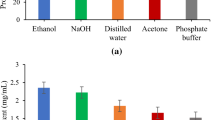Abstract
This study examines the extraction of bromelain from pineapple peels by using an aqueous two-phase system (ATPS). Bromelain from the crude extract predominantly partitioned to the polyethylene glycol rich phase. The best condition for bromelain partitioning was found to be 18% PEG6000-17% MgSO4, which increased purity 3.44-fold with an activity recovery of 206%. Protein patterns and activity staining showed the molecular weight of bromelain to be about 29 kDa. The bromelain showed the highest relative activity at pH 8.0 and at 60°C. When increasing NaCl concentrations (up to 1.5%, w/v), its activity continuously decreased. The bromelain (0–0.3 units) was applied to hydrolyze collagen. The β, α1, α2 components of collagen extensively degraded into small peptides when treated with the bromelain. This study showed that the ATPS can be employed to isolate the bromelain from pineapple peels and the bromelain extract could be used as a meat tenderizing agent.
Similar content being viewed by others
References
Ketnawa S, Chaiwut P, Rawdkuen S. Partitioning of bromelain from pineapple peel (’Nang Lae’ cultv.) by aqueous two phase system. Asian J. Food Agro Ind. 2: 457–468 (2009)
Imandi SB, Bandaru VV, Somalanka SR, Bandaru SR, Garapati HR. Application of statistical experimental designs for the optimization of medium constituents for the production of citric acid from pineapple waste. Bioresource Technol. 99: 4445–4450 (2008)
Schieber A, Stintzing FC, Carle RV. Byproducts of plant food processing as a source of functional compounds recent developments. Trends Food Sci. Tech. 12: 401–413 (2001)
Jamal P, Fahururrazi TM, Zagangir AM. Optimization of media composition for the production of bioprotein from pineapple skins by liquid-state bioconversion. J. Appl. Sci. 93: 3104–3109 (2009)
Umesh HH, Sumana B, Raghavarao KSMS. Use of reverse micellar systems for the extraction and purification of bromelain from pineapple wastes. Bioresource Technol. 99: 4896–4902 (2008)
Lizuka K, Aishima T. Tenderization of beef with pineapple juice monitored by Fourier transform infrared spectroscopy and chemometric analysis. J. Food Sci. 64: 973–977 (1999)
Chuapoehuk P, Raksakulthai N. Use of papain and bromelain in the production of oyster sauce. Asian Food J. 7: 196–199 (1992)
Walsh G. Protein Biochemistry and Biotechnology. John Wiley and Sons, Chichester, UK. pp. 37–38, 419–435 (2002)
Koh J, Kang SM, Kim SJ, Cha MK, Kwon YJ. Effect of pineapple protease on the characteristics of protein fibers. Fibre Polym. 7: 180–185 (2006)
Salampessy J, Phillips M, Seneweera S, Kailasapathy K. Release of antimicrobial peptides through bromelain hydrolysis of leatherjacket (Meuchenia sp.) insoluble proteins. Food Chem. 120: 556–560 (2010)
Maurer HR. Bromelain: Biochemistry, pharmacology, and medical use. Cell Mol. Life Sci. 58: 1234–1245 (2001)
Devakate RV, Patil VV, Waje SS, Thorat BN. Purification and drying of bromelain. Sep. Purif. Technol. 64: 259–264 (2009)
Rowan AD, Buttle DJ, Barrett AJ. The cysteine proteinases of the pineapple plant. Biochem. J. 266: 869–875 (1990)
Doko MB, Bassani V, Casadebaig JL, Jacob M. Preparation of proteolytic enzyme extracts from Ananas comosus L., Merr. fruit juice using semipermeable membrane, ammonium sulfate extraction, centrifugation, and freeze drying process. Int. J. Pharm. 76: 199–206 (1991)
Babu B, Rastogi NK, Raghavarao KSMS. Liquid-liquid extraction of bromelain and polyphenol oxidase using aqueous two-phase system. Chem. Eng. Process. 47: 83–89 (2008)
Nitsawang S. Hatti-Kaul R. Kanasawud P. Purification of papain from Carica papaya latex: Aqueous two-phase extraction versus two-step salt precipitation. Enzyme Microb. Tech. 39: 1103–1107 (2006)
Chaiwut P, Rawdkuen S, Benjakul S. Extraction of protease from Calotropis procera latex by polyethyleneglycol-salts biphasic system. Process Biochem. 45: 1148–1155 (2010)
Ketnawa S, Rawdkuen S, Chaiwut P. Two phase partitioning and collagen hydrolysis of bromelain from pineapple peel ‘Nang Lae’ cultivar. Biochem. Eng. J. 52: 205–211 (2010)
Murachi T. Bromelain enzymes. Vol. I, pp. 475–485. In: Methods in Enzymology. Lorand L (ed). Academic Press, New York, NY, USA (1976)
Bradford MM. A rapid and sensitive method for the quantitation of microgram quantities of protein utilizing the principle of protein-dye binding. Anal. Biochem. 72: 248–254 (1976)
Laemmli UK. Cleavage of structural during assembly of head of bacteriophage T4. Nature 227: 680–685 (1970)
Garcia-Carreno FC, Dimes CE, Haard NF. Substrate gel electrophoresis for composition and molecular weight of proteinases or proteinaceous proteinase inhibitors. Anal. Biochem. 214: 65–69 (1993)
Saito M, Kunisaki N, Urano N, Kimura S. Collagen as the major edible component of sea cucumber (Stichopus japonicus). J. Food Sci. 67: 1319–1322 (2002)
Nalinanon S, Benjakul S, Visessanguan W, Kishimura H. Partitioning of protease from stomach of albacore tuna (Thunnus alalunga) by aqueous two-phase systems. Process Biochem. 44: 471–476 (2009)
Klomklao S, Benjakul S, Visessanguan W, Kishimura H, Simpson BK. Partitioning and recovery of proteinase from spleen by aqueous two-phase systems. Process Biochem. 40: 3061–3067 (2005)
Vallés D, Furtado S, Cantera AMB. Characterization of news proteolytic enzymes from ripe fruits of Bromelia antiacantha Bertol (Bromeliaceae). Enzyme Microb. Tech. 40: 409–413 (2007)
Bruno MA, Sebastian A, Trejo Xavier F, Nestor A, Caffini O, Laura M, Lopez I. Isolation and characterization of Hieronymain II, another peptidase isolated from fruits of Bromelia hieronymi Mez. (Bromeliaceae). Protein J. 25: 1–7 (2006)
Kaul RH. Aqueous Two-phase Systems. Humana Press Inc., New York, NJ, USA. pp. 269–277 (2000)
Sikorski ZE. Chemical and Functional Properties of Food Protein. Technomic Publishing, Lancaster, CA, USA. pp. 233–256 (2001)
Author information
Authors and Affiliations
Corresponding author
Rights and permissions
About this article
Cite this article
Ketnawa, S., Chaiwut, P. & Rawdkuen, S. Aqueous two-phase extraction of bromelain from pineapple peels (‘Phu Lae’ cultv.) and its biochemical properties. Food Sci Biotechnol 20, 1219 (2011). https://doi.org/10.1007/s10068-011-0168-5
Received:
Revised:
Accepted:
Published:
DOI: https://doi.org/10.1007/s10068-011-0168-5




